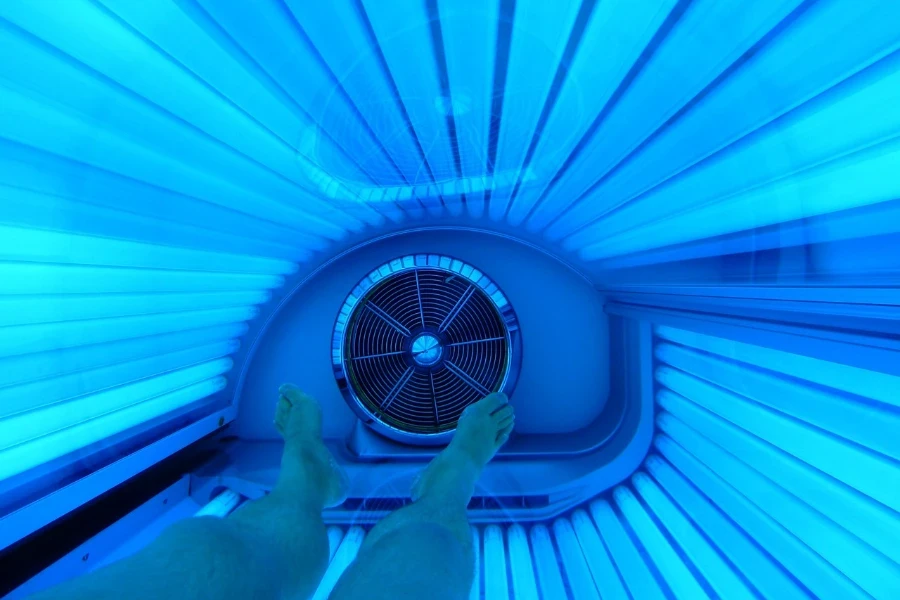A refreshing tan is an incredibly unique experience that makes consumers feel like they just returned from a sun-soaked beach vacation. But what if they live in areas with colder temperatures or limited sunshine? The tan they enjoy won’t last very long.
Although going to a tanning salon is a viable solution, not everyone can handle the cost and time of frequent visits. That’s when they’ll consider getting a home tanning bed, and businesses must be ready to handle this demand.
This article will serve as a guide, showing retailers everything they need to successfully sell tanning beds in 2024.
Table of Contents
Overview of the global tanning bed market
Types of tanning beds
6 factors worth considering when searching for tanning beds
Wrapping up
Overview of the global tanning bed market
With over 70% of light skin types deliberately attempting to darken their skin, it’s no surprise that indoor tanning is a common behavior, especially among young adults. Experts predict the global tanning bed market will experience a 6.0% compound annual growth rate (CAGR) to reach US $7.4 billion by 2027.
The benefits of tanning beds, including enhanced mood, improved appearance, and increased vitamin D levels, are helping to drive market growth. The rising demand for personal/luxury care treatments and advancements in tanning tech are also boosting market growth.
Europe generated the largest market share, and experts say the region will remain dominant over the forecast period. However, North America follows closely behind due to the widespread indoor tanning in the region.
Types of tanning beds

After their debut in the 1920s, tanning beds have gone through a necessary journey to provide the services consumers enjoy today. From the first tanning salon opening in Berlin, Germany, in 1977 to tanning beds becoming popular in the late 70s and 80s, they are now all over Europe and America.
Although tanning beds were originally salon exclusives, variants now exist for home use. For this reason, businesses can sell two types of tanning bed: commercial and residential.
Commercial tanning beds
Commercial tanning beds are what people mostly see in tanning salons. Large designs accommodate various consumer heights, shapes, and sizes.
These units may even offer appealing advanced tech features, like air conditioning and aromatherapy. More importantly, commercial tanning beds are powerful, making them the best option to glow up in a few minutes.
Residential tanning beds
Although commercial tanning beds were a big hit, they had a major issue. Not everyone could afford frequent salon visits to keep their beautiful tans.
And commercial variants are big units that simply won’t fit in a regular home setting. So, manufacturers created residential tanning beds that could work in a basement, garage, or backyard.
More importantly, they have lighter designs and need less power to operate. While they may not be as powerful as their commercial counterparts, residential tanning beds more than make up for them with convenience and comfort.
6 factors worth considering when searching for tanning beds
1. Durability and space required
One of the most important things to watch out for is material and durability—these factors depend on the unit’s purpose. While consumers may use home tanning beds a few times a week, commercial variants can work several shifts daily at different wattages, making them more durable.
For this reason, commercial models are heavy-duty, with manufacturers making them from thicker acrylic parts to ensure durability. However, this aspect also makes them larger than what’s required for homeowners.
On the other hand, residential tanning beds come with slimmer designs that take up less room. But here’s the catch: they sacrifice some durability to achieve their smaller sizes, meaning they need more delicate care to work effectively for longer.
2. Power consumption
Tanning beds are machines that draw significant power, but both types do it differently. For instance, manufacturers design commercial tanning beds to power up fast since salons will turn them on and off several times daily.
The downside is that they’ll need a lot of power to complete this feat, so they’re restricted to salons. Commercial tanning beds average 1,500 to 2,500 watts of power, meaning they can use up to 2.5 kilowatts per hour.
In contrast, residential tanning beds may take longer to power up, but they’re not power-hungry units. Using commercial tanning beds at home can send the consumer’s electricity bill through the roof, so offering them a residential version is the better choice.
Ideally, residential tanning beds should consume between 1,000 and 1,500 watts. The most energy-efficient range provides enough power for a safe and effective tanning session. Anything higher than that won’t be fit for home use.
3. Tanning bed shape
Usually, tanning beds come in two popular shapes: horizontal lie-down and vertical stand-up options. Horizontal tanning beds are the most common types available, and they offer an incredibly comfortable, convenient tanning experience—consumers can relax while the machine does its thing.
While horizontal beds are perfect for long tanning sessions, vertical variants are the go-to for quick and easy tans. While they take up less space, they can get very uncomfortable if consumers use them for long periods of time.
4. Number of lamps
The number of lamps in a tanning unit determines its UV-ray strength. In this case, higher isn’t the best. Consumers don’t need tanning beds with higher lamp counts to rock their desired bronze level—and more lamps mean higher power consumption.
On this note, commercial tanning beds offer between 24 and 48 lamps, while the most anyone can see in residential models is 36. Thankfully, most residential tanning beds offer 24 lamps, with some going as low as 16.
5. High or low-pressure bulbs
Tanning beds often offer different pressure levels, determining their UVA ray intensity. For instance, levels 1 and 2 units offer low-pressure bulbs with higher UVA emissions.
Conversely, levels 3 to 6 models use high-pressure bulbs that generate lower UVA rays. Low-pressure bulbs are ideal for infrequent users, while high-pressure variants are the best for maintaining tans over extended periods.
6. Consumer skin type
It’s common knowledge that consumers have different skin types, so naturally, some users will see better results under tanning beds than others. Moreover, it depends on the UV lamp’s strength.
Consumers with more sensitive skin or those susceptible to burns will see home tanning beds as a better offer—especially models with fewer lamps and lower UV lights.
Wrapping up
Tanning beds are fantastic machines that transform something once restricted to the outdoors into a thrilling indoor experience. However, the type of products businesses should purchase depends on the target consumers.
If retailers prefer selling to salons, they must stock up on commercial tanning beds. They have all the requirements to provide the best experience for multiple people. But if the focus is on homes, residential models are the way to go.
Consider these tips to give consumers the bronze they desire in 2024.




